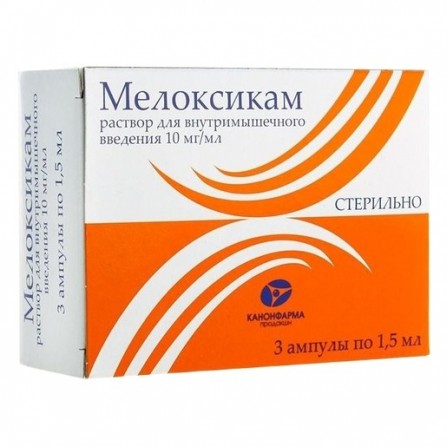Meloxicam solution for intramuscular injection of an ampoule 1.5 ml 3 pcs
Condition: New product
1000 Items
Rating:
Be the first to write a review!

More info
Active ingredients
Meloxicam
Composition
1 ml of meloxicam 10 mg. Excipients: meglumin - 7 mg, glycine - 6 mg, poloxamer 188 - 50 mg, glycofurfurol - 100 mg, sodium chloride - 3.
Pharmacological effect
NSAIDs, a selective COX-2 inhibitor. It belongs to the class of oxycams, is a derivative of enolic acid. It has anti-inflammatory, analgesic and antipyretic effects. The mechanism of action is associated with a decrease in the biosynthesis of prostaglandins as a result of the inhibition of the enzymatic activity of COX. At the same time, meloxicam has a more active effect on COX-2, which is involved in the synthesis of prostaglandins in the inflammatory focus, which reduces the risk of side effects on the upper GI tract and slightly affects COX-1. At the same time, meloxicam does not affect the synthesis of proteoglycan by chondrocytes of articular cartilage, does not affect the development of spontaneous arthrosis in rats and mice, which indicates its chondroneutrality.
Pharmacokinetics
After ingestion or rectal administration, the absorption of meloxicam from the gastrointestinal tract is 89%. Meal does not affect the absorption of meloxicam. Plasma concentration is dose dependent. The plateau of plasma concentration is reached in 3-5 days. With prolonged use (more than 1 year) there is no increase in plasma concentration compared to the level reached when reaching the plateau. In plasma, 99% of meloxicam is in a conjugated form with proteins. The fluctuations in the concentration of meloxicam when taken 1 time / day are small and are within 0.4-1 μg / ml for a dose of 7.5 mg and 0.8-2 μg / ml for a dose of 15 mg. The concentration of meloxicam in synovial fluid is 50% of the concentration in the blood plasma. Meloxicam is almost completely metabolized to inactive metabolites. T1 / 2 meloxicam is 20 hours. Plasma clearance averages 8 ml / min. Meloxicam is excreted by the kidneys and through the intestines in approximately equal proportions. Mild to moderate hepatic and renal impairment do not significantly affect the pharmacokinetic parameters of meloxicam.
Indications
Inflammatory and degenerative diseases of the joints (arthrosis, osteoarthritis), rheumatoid arthritis, ankylosing spondylitis (ankylosing spondylitis).
Contraindications
Peptic ulcer and duodenal ulcer in the acute phase, pronounced abnormal liver function, renal failure (without hemodialysis), pregnancy, childhood and adolescence to 15 years, hypersensitivity to meloxicam and other NSAIDs (including salicylates).
Use during pregnancy and lactation
Contraindicated for use in pregnancy. If necessary, use during lactation should decide on the termination of breastfeeding. In experimental studies revealed no teratogenic effects of meloxicam.
Dosage and administration
Inside of 7.5-15 mg 1 time / day. The maximum daily dose is 15 mg. Outwardly used 2 times / day. Apply a thin layer to clean, dry skin over the lesion and rub it gently for 2-3 minutes.
Side effects
On the part of the digestive system: dyspepsia, nausea, vomiting, abdominal pain, constipation, intestinal colic, diarrhea, esophagitis, stomatitis; rarely - erosive and ulcerative lesions of the digestive tract. From the side of the central nervous system: dizziness, headache, tinnitus. Since the cardiovascular system: increased blood pressure, palpitations, swelling, hot flashes. On the part of the urinary system: changes in laboratory parameters of renal function. From the hemopoietic system: anemia, leukopenia, thrombocytopenia. Allergic reactions: bronchospasm, photosensitivity, pruritus, rash, urticaria.
Interaction with other drugs
With simultaneous use may reduce the effectiveness of antihypertensive drugs (beta-blockers, ACE inhibitors, vasodilators). With simultaneous use with anticoagulants increases the risk of bleeding. With simultaneous use with diuretics increases the risk of renal failure in patients in a state of dehydration. With simultaneous use with NSAIDs increases the risk of ulceration of the gastrointestinal tract and gastrointestinal bleeding. With simultaneous use with lithium preparations increases the concentration of lithium in the blood plasma. With simultaneous use of Kolestiramin accelerates the elimination of meloxicam. With simultaneous use with methotrexate may increase myelodepressive action; with cyclosporine - may increase the nephrotoxic effect of cyclosporine.
special instructions
With caution used in patients with gastrointestinal tract history.


